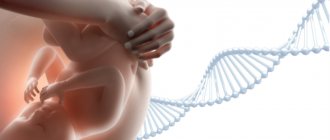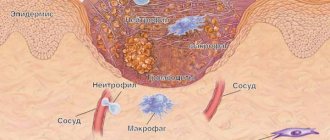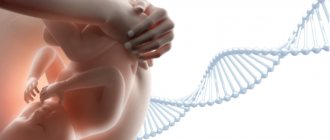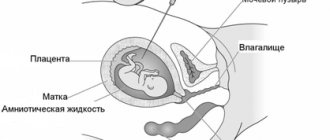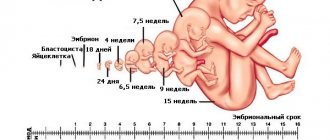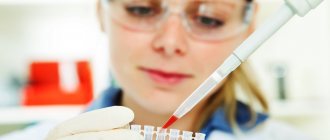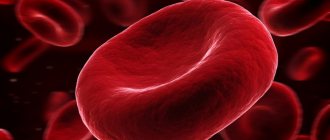Pregnancy is a physiological process. But this is a very difficult and responsible period in a woman’s life, which causes a complete restructuring of the functions and structure of the female body. The functional restructuring of the endocrine system causes a revolution in all metabolisms, therefore proper nutrition is the basis for the favorable course of the entire pregnancy, the basis for maintaining the health of the mother and the normal development of the child.
Fats during pregnancy
During pregnancy, enormous hormonal changes occur. In this regard, the level of all lipoproteins and cholesterol in the blood increases. When consuming large amounts of animal fats, the digestive system is overloaded and these indicators become even higher. Therefore, pregnant women are recommended to reduce their fat intake to 80 g per day, of which 40-45% (about 35 g) should be milk fats (butter, sour cream), 35-40% (about 30 g) vegetable fats. Vegetable fats are very important during pregnancy; they are the main source of polyunsaturated fatty acids and vitamin E.
But the fats that should be increased during pregnancy are omega-3 fatty acids. They are the ones that are necessary for building the fetal nervous system , especially in the third trimester. And if we take into account the fact that the fetal nervous system begins to develop and differentiate in the 2-4th week of pregnancy, then the level of these acids in the diet should be increased from the very beginning. According to EU recommendations, omega-3 fatty acids in the diet of a pregnant woman should be at least 0.5% of the energy value of the daily diet, this is 1.2 g with a caloric intake of 2000 per day.
The largest amount of these fats is found in fatty fish, exclusively in sea fish. Mackerel contains about 1.8-5.3 g of omega-3 fatty acids per 100 g of fish, herring - 1.2-3.1 g, salmon - 1.0-1.4 g, trout and tuna 0.5-1.6 g, Atlantic sardines 1.4 g, but in cod there is only 0.2-0.3 g per 100 g of product. But it should be remembered that when frying, most of these beneficial fatty acids will be destroyed, so lightly salted fatty fish will bring the greatest benefit. But this product will be limited in the presence of arterial hypertension and swelling. Red and black caviar contain a huge amount of omega-3 fatty acids: more than 6 g per 100 g of product. Shark, swordfish, king mackerel and tilefish are rich in omega-3 fatty acids, but pregnant women should avoid these foods due to their high mercury content.
Among herbal products, flax oil should be noted . 100 g of this oil contains about 53 g of omega-3 fatty acids. While sunflower oil has no omega-3 fatty acids at all, olive and corn oil have only 1.1 g and 0.7 g per 100 g of product. But flax oil should be consumed exclusively in fresh form (without heat treatment) and it should be exclusively cold-pressed.
Walnuts are rich in omega-3 fatty acids: 9 g per 100 g of product.
It is also important to maintain the ratio between polyunsaturated omega-3 and omega-6 fatty acids: 1:4. Walnuts and pistachios can be considered balanced in terms of these indicators.

Prenatal screening or blood test of pregnant women for markers of fetal pathology
Blood test of pregnant women for markers (French marqueur, from marquer - mark) of fetal pathology or biochemical screening of pregnant women.
This blood test serves as the only means of searching for developmental abnormalities and pathologies of the fetus, because it reflects the condition of the fetus and placenta through specific proteins that penetrate into the blood of the pregnant woman.
Timely detection of changes allows the doctor to form risk groups for pregnant women with chromosomal abnormalities of the fetus.
Currently, according to the order of the Ministry of Health of Ukraine No. 417 dated July 15, 2011, biochemical screening is carried out in two stages - screening of the first trimester (11 weeks + 1 day - 13 weeks + 6 days); and second trimester screening (18-21 weeks).
During early biochemical screening (first trimester screening), the level of two placental proteins is determined in the blood of a pregnant woman: PAPP-A (pregnancy associated plasma protein or pregnancy-associated plasma protein A) and the free beta subunit of hCG (human chorionic gonadotropin). This analysis is called a “double test”.
Various changes in the level of early markers indicate an increased risk of the fetus having chromosomal and some non-chromosomal disorders. Suspicion of the presence of Down syndrome in the fetus is caused by a decrease in the level of PAPP-A and an increase in the level of the free beta subunit of hCG.
For biochemical screening of the second trimester (18-21 weeks), the level of AFP (alphafetoprotein), hCG (human chorionic gonadotropin) and free (unconjugated) estriol is most often determined in the blood of a pregnant woman. This analysis is called the “triple test”. A significantly increased level of AFP is observed in cases of gross malformations of the fetal brain and spinal cord, in unfavorable course of pregnancy, threat of miscarriage, Rh conflict, intrauterine fetal death and is a prognostically unfavorable sign.
In multiple pregnancies, elevated AFP levels are normal. A reduced level of AFP can occur with Down syndrome, with a low-lying placenta, obesity, diabetes mellitus, or hypothyroidism in a pregnant woman. May occur during normal pregnancy. There is a dependence of AFP level on race.
HCG and free estriol are proteins of the placenta, their level characterizes the state of the placenta at a particular stage of pregnancy; it can change if the fetus (and, accordingly, the placenta) has chromosomal abnormalities, if there is a threat of miscarriage, or changes in the placenta due to infectious damage. Altered levels of hCG and free estriol may occur during a normal pregnancy.
Typical in the presence of Down syndrome in a fetus is an increased level of hCG in combination with a decreased level of AFP and free estriol.
The level of serum markers in the blood of pregnant women changes in accordance with the stage of pregnancy.
Since laboratories use different standards for assessing markers, depending on the reagents used, it is customary to evaluate the levels of serum markers in relative units - MoM (multiples of median - a multiple of the average value).
| Typical MoM Profiles - First Trimester | ||
| Anomaly | PAPP-A | Free β-hCG |
| Tr.21 (Down syndrome) | 0,41 | 1,98 |
| Tr.18 (Edwards syndrome) | 0,16 | 0,34 |
| Triploidy type I/II | 0,75/0,06 | |
| Shereshevsky-Turner syndrome | 0,49 | 1,11 |
| Klinefelter syndrome | 0,88 | 1,07 |
Typical MoM Profiles - Second Trimester
| Anomaly | AFP | General hCG | St. estriol |
| Tr.21 (Down syndrome) | 0,75 | 2,32 | 0,82 |
| Tr.18 (Edwards syndrome) | 0,65 | 0,36 | 0,43 |
| Triploidy type I/II | 6,97 | 13 | 0,69 |
| Shereshevsky-Turner syndrome | 0,99 | 1,98 | 0,68 |
| Klinefelter syndrome | 1,19 | 2,11 | 0,60 |
A change in any one biochemical screening indicator is not significant.
It is correct to evaluate the results of prenatal screening using computer programs for calculating genetic risk, which take into account the individual indicators of each pregnant woman - age, weight, ethnicity, and the presence of certain diseases. Fetal ultrasound data.
Calculation results Pr. Risk scores are not a diagnosis of a disease, but rather an assessment of individual risk.
Currently, the most commonly used strategy is to sequentially combine risk determined from first- and second-trimester screening using computer modeling. In this step-by-step sequential strategy, couples are called “screen-positive” for Down syndrome if the gestational age is confirmed by ultrasound and the estimated risk is equal to or greater than the risk for a 35-year-old woman. At this point, the couple may be offered invasive prenatal testing because their risk for autosomal trisomy has reached the level of that of older women who are offered an invasive procedure. The remaining couples with less increased risk then undergo testing in the second trimester, with combined results from both the first and second trimester used to determine the indication for an invasive procedure. This strategy can detect up to 95% of all cases of Down syndrome with a false-positive rate of about 5%.
To ensure computer automation and data processing during 2-stage prenatal screening, licensed equipment and reagents were installed at the GLORI KDL for the implementation of the Hem Down Syndrome Risk Calculator (DSRC) program, developed jointly by specialists from the Prenatal Diagnostics Laboratory of the Research Institute of PAG named after. BEFORE. Ott RAMS and Intelligent Software Systems LLC (St. Petersburg). The program calculates the gestational age based on the conclusion made on the basis of ultrasound, and automatically requests the input of parameters for the 1st or 2nd trimesters of pregnancy. In addition to the duration of pregnancy, the program takes into account the weight of the pregnant woman, the number of fetuses and race, and the presence of diabetes. In a separate file, statistical data on all conducted studies is automatically accumulated and own medians are generated for the entire period of use of the program by the user.
PS!!! – If the Down Syndrome Risk Calculator program indicators are critical (less than 1:250), it is strictly recommended to refer the pregnant woman for consultation to the regional medical genetic center.
Proteins during pregnancy
Protein is the main building material. The need for protein increases with the growth of the uterus, fetus, placenta and mammary glands. For the normal development of the body of mother and child, an adequate amount of protein is necessary , and it must be of high quality.
In the first half of pregnancy, the daily protein requirement is calculated as follows: for every kilogram of a woman’s actual weight, 0.75 g of protein is needed, plus an additional 10 g.
In the second half of pregnancy, the daily protein requirement is calculated as follows: for every kilogram of a woman’s actual weight, 0.75 g of protein is needed, plus an additional 30 g. Of these, 65% should be of animal origin.
Carbohydrates in pregnant women's diet should be about 50-55%, which is about 350 g per day. Preference should be given to products that combine “pleasant and healthy”, that is, they combine the presence of sweet fructose, dietary fiber, vitamins and microelements. These products include fruits and dried fruits.
It is recommended to eat about 35 g of fiber per day (except for fruits, these are vegetables and coarse grains), but the amount of sugar and simple sweet foods should be limited to 40-50 g per day. This is necessary to prevent the development of diabetes mellitus in pregnant women and excess fetal weight.
Causes of increased protein in urine
Mild proteinuria can occur for a completely harmless reason. You are too tired after prolonged physical activity, have experienced stress, or have overeaten foods rich in protein compounds. Even simple hypothermia can increase protein in the urine.
Physiologically, albumin can occur when the kidneys change their position due to changes in the spine or pressure from the uterus. Another negative factor is dehydration, which develops as a result of insufficient water intake or excessive sweating. Usually, when retesting, traces of protein are not detected in this case.
Protein content above 3 g/l is due to the following reasons:
- Pyelonephritis in pregnant women.
This is inflammation in the kidneys. It occurs when the movement of urine through the urinary tract is disrupted, and microbes begin to multiply in them.
- Glomerulonephritis.
Infectious lesion of the glomerular apparatus of the kidneys. The main pathogens are streptococcus and staphylococcus.
- Renal cyst.
A formation on the surface of the kidney filled with fluid. It develops during pregnancy if a woman drinks alcohol, smokes, is constantly in contact with harmful chemicals, or has been exposed to x-rays.
- Stones in the kidneys or bladder.
They are formed when water-salt metabolism is disrupted, as a result of stress and due to unfavorable heredity.
- Preeclampsia.
Severe syndrome of the 3rd trimester of pregnancy, when a woman’s body ceases to cope with the tasks of providing the fetus with the necessary nutrition and oxygen.
Consequences of inadequate nutrition
The issue of nutrition during pregnancy is vitally important, has been thoroughly studied, and at the same time remains for most doctors and especially expectant mothers beyond the scope of problems that should be seriously worried about. In fact, the first time most pregnant women hear anything about nutrition from their doctor is when they gain excess weight or when their blood glucose level is high. By interviewing your friends, you can easily make sure that even very conscientious and attentive doctors do not worry if a woman weighs little or does not gain enough. Meanwhile, with improper and inadequate nutrition, the following serious complications can arise.
For the expectant mother:
- Late toxicosis of pregnancy (preeclampsia) is a painful condition in which fluid retention in the body (hydropsis of pregnant women), loss of protein in the urine, and increased blood pressure develop successively. Ultimately, if left untreated, severe brain complications develop, including seizures and coma, hemorrhages in vital organs, and the mother and child may die. Modern official medicine states that the cause of this condition is unknown. It is not true! It will be shown below that it is known and easily preventable.
- Miscarriage (premature birth and miscarriages) - because Due to improper nutrition, the placenta cannot develop normally.
- Premature placental abruption - close to childbirth, the placenta begins to separate from the wall of the uterus, the baby may die (50% chance), and the mother experiences bleeding. This occurs, among other things, due to the tendency to thicken the blood and form blood clots in the vessels of the uterus and placenta.
- Anemia (anemia) - due to insufficient intake or absorption of proteins, iron, and vitamins.
- Infectious complications, including those of the lungs, liver and kidneys.
- Weak labor, prolonged labor, exhaustion of the expectant mother during childbirth.
- Postpartum hemorrhage and decreased blood clotting.
- Slow healing of perineal wounds, the uterus contracts slowly after childbirth.
The child has:
- Intrauterine growth retardation, and intrauterine death is also possible.
- Low birth weight, as well as prematurity, low viability.
- Encephalopathy, decreased mental abilities.
- Hyperexcitability and hyperactivity.
- Reduced resistance to infections in utero, during and after childbirth, susceptibility to various diseases.
- Convincing yourself to take care of proper nutrition is not easy, but the results are worth it.
Prevention of proteinuria
The best way to prevent any pregnancy complications is to plan and prepare the body for conception. Give up bad habits, undergo a medical examination and treatment for hidden infections.
To reduce the risks associated with high protein in your urine, do not skip routine visits to your doctor and get tested before each appointment. Monitor your weight gain and measure your blood pressure regularly. Eliminate “harmful” foods from the menu. If your health worsens, be sure to inform your doctor.
You can get a urine test for protein at an affordable price at the Women's Medical Center. Completion time: 1 day. You will receive a detailed result containing data on protein, leukocytes, red blood cells and other important indicators. You can decipher the analysis by scheduling a consultation with a Center specialist.
Basic principles of nutrition for pregnant women
- Complete satisfaction of the physiological needs of a pregnant woman for nutrients and energy.
- Maximum variety of diet including all food groups.
- Ensuring additional intake in the second half of pregnancy:
- squirrel;
- energy;
- calcium and iron;
- dietary fiber.
- Additional intake of vitamin and mineral preparations.
- Limiting the consumption of salt, salty foods, liquids.
- Limit your consumption of foods high in saturated fats and simple carbohydrates.
- Limiting the consumption of foods with a high allergenic potential, as well as foods rich in essential oils, spices and herbs.
- Exclusion from the diet of coffee, alcoholic and carbonated drinks.
The menu for pregnant women should include:
- traditional food products;
- traditional food products enriched with essential macro- and micronutrients;
- functional food products, including dietary (therapeutic and preventive) food products.
Among traditional products, special attention should be paid to:
- cereals
- a variety of vegetables and fresh herbs (parsley, dill, cilantro and other leafy greens)
- potatoes
- fruits (pregnant women should avoid eating large amounts of exotic fruits, including citrus fruits)
- fermented milk drinks
- meat products
- mackerel
- herring
- sardines
- "fatty" fish
- vegetable oils.
Causes of protein deficiency
There are plenty of reasons for malnutrition in a cancer patient:
- aversion to food during chemotherapy and the toxic effects of drugs on the mucous membranes, blood and endocrine glands;
- painful local complications of radiation, especially the oral cavity, abdominal organs and rectum;
- severe combined operations with the removal of several organs and a long recovery period with inevitable dietary restrictions;
- the increasing need of a growing tumor for building and energy material, robbing all healthy organs, which inevitably reduces their functionality;
- activation of the breakdown of protein molecules circulating in the blood under the influence of aggressive products and toxins of tumor cells;
- the impossibility of adequate nutrition when the gastrointestinal tract is damaged.
A special case of protein deficiency is the loss of protein molecules along with ascitic fluid removed from the abdominal cavity during peritoneal carcinomatosis.
To start PEM, it is enough to limit the supply of food nutrients for several days, the rest will be done by the tumor and the characteristics of the patient’s body created by it: the rapid destruction of proteins is potentiated, with the impossibility of synthesizing essential amino acids and the constantly growing need of malignant cells for building materials and energy.
Why is proteinuria dangerous?
Without timely treatment, the appearance of protein in the urine is accompanied by serious pregnancy complications:
- swelling of the limbs, face and internal organs;
- constant vomiting;
- arrhythmia and shortness of breath;
- high pressure inside blood vessels;
- renal failure;
- premature aging of the placenta and the threat of miscarriage;
- fetal hypoxia and related disorders.
The danger of gestosis and preeclampsia lies in the rapid increase in symptoms. Blood pressure rises, convulsions appear, the woman may lose consciousness and even fall into a coma. Hypertension increases the risk of hemorrhagic stroke.
Bacterial urinary tract infections cause blood poisoning. If bacteria enter the amniotic fluid, the baby will become infected before birth.
Therefore, any deviations in the results of urine tests during pregnancy require additional diagnostics, specialist consultation and treatment.

